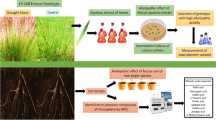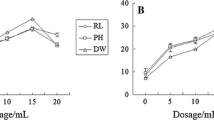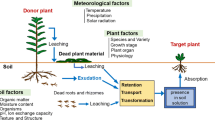Abstract
Allelopathy in rice (Oryza sativa, L.) effective against weeds has been found in about 3.5% of tested rice germplasm in both laboratory and field experimentation. However, the allelochemicals responsible for growth inhibition of rice-associated weeds have not yet been identified. In the literature, phenolic acids are often mentioned as putative allelochemicals. If phenolic acids commonly reach growth inhibitory concentrations in rice ecosystems, it must be expected that the degree of tolerance to phenolic acids will vary among traditional rice cultivars or plant species adapted to rice environments having inherently different phenolic acid concentrations. Phenolic acids concentrations are normally greater in submerged than in aerobic soils. A dose–response study, however, showed that seedlings of rice cultivars adapted to submerged anaerobic soils did not have higher level of tolerance against p-hydroxybenzoic acid than did seedlings of varieties adapted to aerobic upland soils. Moreover, traditional rice cultivars had no greater tolerance than did improved cultivars that were recently bred for traits other than tolerance of phenolic acids. Similarly, there were no differences in tolerance of p-hydroxybenzoic acid between two Echinochloa weed species adapted to either anaerobic or aerobic growth conditions. Thus, neither the rice cultivars nor weed species had evolved different tolerance levels against the phenolic acid. However, all rice cultivars had significantly greater tolerance of p-hydroxybenzoic acid than did either weed species. In a second experiment, the rates at which rice plants released phenolic acids into solution cultures were measured for at least one month, the time period of greatest allelopathic activity following planting under field conditions. The maximum release rate of phenolic acids during the first month of growth was approximately 10 μg/plant/day. At a conventional plant density, the release rate of phenolic acids would be approximately 1 mg/m2day. This order of release rate cannot provide concentrations remotely close to phytotoxic levels determined for these rice cultivars and weed species. The results presented in this paper do not preclude the possibility that phenolic acids might be one component in a mixture of chemicals that, when present simultaneously, are allelopathic.
Similar content being viewed by others
REFERENCES
Appel, H. M. 1993. Phenolics in ecological interactions: The importance of oxidation. J. Chem. Eco. 19:1521–1552.
Blum, U. 1996. Allelopathic interactions involving phenolic acids. J. Nematol. 28:259–267.
Blum, U. 1998. Effects of microbial utilization of phenolic acids and their phenolic breakdown products on allelopathic interactions. J. Chem. Ecol. 24:685–708.
Box, G. E. P. and Cox, D. R. 1964. An analysis of transformations. J. R. Stat. Soc. Seri. B 26:211–246.
Carroll, R. J. and Ruppert, D. 1988. Transformation and Weighting in Regression. Chapman & Hall, London, England, 249 pp.
Cheng, H. H. 1995. Characterization of the mechanisms of allelopathy: Modeling and experimental approaches, pp. 132–141, in Inderjit, K. M. M. Dakshini, and F. A. Einhellig (eds.). Allelopathy: Organisms, Processes and Applications. American Chemical Society, Washington, D.C.
Chou, C.-H. and Chiou, S.-J. 1979. Autointoxication mechanism of Oryza sativa II. Effects of culture treatments on the chemical nature of paddy soil on rice productivity. J. Chem. Ecol. 5:839–859.
Chou, C.-H., Lin, T.-J., and Kao, C.-I. 1977. Phytotoxins produced during decomposition of rice stubbles in paddy soil and their effect on leachable nitrogen. Bot. Bull. Acad. Sini. 18:45–60.
Chou, C.-H., Chiang, Y.-C., and Cheng, H. H. 1981. Autointoxication mechanism of Oryza sativa. III. Effect of temperature on phytotoxin production during rice straw decomposition in soil. J. Chem. Ecol. 7:741–752.
Clesceri, L. S., Greenberg, A. E., and Trussell, R. R. 1989. Phenols, pp. 5-48–5-54, in Standard Methods for the Examination of Water and Wastewater, 17th ed. American Public Health Association, Washington, D.C.
Dalton, B.R. 1999. The occurrence and behavior of plant phenolic acids in soil environments and their potential involvement in allelochemical interference interactions: Methodological limitations in establishing conclusive proof of allelopathy, pp. 57–74, inInderjit, K. M. M. Dakshini, and C. L. Foy (eds.). Principles and Practices in Plant Ecology: Allelochemical Interactions. CRC Press, Boca Raton, Florida.
Dilday, R. H., Yan, W. G., Moldenhauer, K. A. K., and Gravois, K. A. 1998. Allelopathic activity in rice for controlling major aquatic weeds, pp. 7–26, in M. Olofsdotter (ed.) Allelopathy in Rice. International Rice Research Institute, Manila, Philippines.
Einhellig, F. A. 1999. An integrated view of allelochemicals amid multiple stresses, pp. 479–494, in Inderjit, K. M. M. Dakshini, and C. L. Foy (eds.). Principles and Practices in Plant Ecology: Allelochemical Interactions. CRC Press, Boca Raton, Florida.
Foy, C. L. 1999. How to make bioassays for allelopathy more relevant to field conditions with particular reference to cropland weeds, pp. 25–33, in Inderjit, K. M. M. Dakshini, and C. L. Foy (eds.). Principles and Practices in Plant Ecology: Allelochemical Interactions. CRC Press, Boca Raton, Florida.
Fujii, Y. 1992. The potential biological control of paddy weeds with allelopathy: Allelopathic effect of some rice varieties, pp. 305–320, in Proceedings of the International Symposium on Biological Control and Integrated Management of Paddy and Aquatic Weeds in Asia. National Agricultural Research Center, Tsukuba, Japan.
Gotoh, S. and Onikura, Y. 1971. Organic acids in a flooded soil receiving added rice straw and their effect on the growth of rice. Soil Sci. Plant Nutri. 17:1–8.
Hartley, R. D. and Whitehead, D. C. 1985. Phenolic acids in soils and their influence on plant growth and soil microbial processes, pp. 109–262, in D. Vaughan and R. E. Malcolm (eds.). Soil Organic Matter and Biological Activity. Developments in Plant and Soil Sciences, Vol. 16. Martinus Nijhoff/Dr W. Junk Publishers. Dordrecht, The Netherlands.
Hsu, F.-H., Chiu, C.-Y., and Chou, C.-H. 1989. Action model of allelopathic compounds on seed germination, pp. 315–327, in C. H. Chou and G. R. Waller (eds.). Phytochemical Ecology: Allelochemicals, Mycotoxins and Insect Pheromones and Allomones Academica Sinica Monograph Series. No. 9.
Huang, P. M., Wang, M. C., and Wang, M. K. 1999. Catalytic transformation of phenolic compounds in the soils, pp. 287–306, in Inderjit, K. M. M. Dakshini, and C. L. Foy (eds.). Principles and Practices in Plant Ecology: Allelochemical Interactions. CRC Press, Boca Raton, Florida.
Jordan, N. R. and Jannink, J. L. 1997. Assessing the practical importance of weed evolution: A research agenda. Weed Res. 37:237–246.
Kuwatsuka, S. and Shindo, H. 1973. Behavior of phenolic substances in the decaying process of plants I. Identification and quantitative determination of phenolic acids in rice strawand its decayed product by gas chromatography. Soil Sci. Plant Nutr. 19:219–227.
Mattice, J., Lavy, T., Skulman, B., and Dilday, R. 1998. Searching for allelochemicals in rice that control ducksalad, pp. 81–98, in M. Olofsdotter (ed.). Allelopathy in Rice. International Rice Research Institute, Manila, Philippines.
Navarez, D. and Olofsdotter, M. 1996. Relay seeding technique for screening allelopathic rice (Oryza sativa). Proceedings of the 2nd International Weed Control Conference, pp. 1285–1290, in H. Brown, G. W. Cussans, M. D. Devine, S. O. Duke, C. Fernandez-Quantilla, A. Helweg, R. E. Labrada, M. Landes, P. Kudsk, and J. C. Streigbig (eds.). Published by Department ofWeed Control and Pesticide Ecology, Copenhagen, Denmark.
Niemeyer, H. M. 1988. Hydroxamic acids (4-hydroxy-1,4-benzoxazin-3-ones), defence chemicals in the Gramineae. Phytochemistry 27:3349–3358.
Niranjan rao, D. and Mikkelsen, D. S. 1976. Effect of rice straw incorporation on rice plant growth and nutrition. Agron. J. 68:752–755.
Olofsdotter, M. and Navarez, D. 1996. Allelopathic rice in Echinochloa crus-galli control. Proceedings of the 2nd International Weed Control Conference, Vol 4, pp. 1175–1182.
Olofsdotter, M., Navarez, D., Rebulanan, M., and Streibig, J. C. 1999. Weed suppressing rice cultivars—does allelopathy play a role? Weed Res. 39:441–454.
Pheng, S., Adkins, S. Olofsdotter, M., and Jahn. G. 1999. Allelopathic effects of rice (Oryza sativa L.) on the growth of awnless barnyard grass [Echinochloa colona (L.) Link]: A new form for weed management. Cambodian J. Agric. 2:42–49.
Reigosa, M. J., Souto, X. C., and Gonzalez, L. 1999. Effect of phenolic compounds on the germination of six weed species. Plant Growth Regul. 28:83–88.
Rimando, A. M., Dayan, F. E., Czarnota, M. A., Weston, L. A., and Duke, S. O. 1998. A new photosystem II electron transfer inhibitor from Sorghum bicolor. J. Nat. Prod. 61:927–930.
Schmidt, S. K. and Ley, R. E. 1999. Microbial competition and soil structure limit the expression of allelochemicals in nature, pp. 339–351, in Inderjit, K. M. M. Dakshini, and C. L. Foy (eds.). Principles and Practices in Plant Ecology: Allelochemical Interactions. CRC Press, Boca Raton, Florida.
Shindo, H. and Kuwatsuka, S. 1977. Behavior of phenolic substances in the decaying process of plants. VI. Changes in quality and quantity of phenolic substances in the decaying process of rice straw in a soil. Soil Sci. Plant Nutr. 23:319–332.
Shindo, H., Marumoto, T., and Higashi, T. 1979. Behavior of phenolic substances in the decaying process of plants. X. Distribution of phenolic acids in soils of greenhouses and fields. Soil Sci. Plant Nutr. 25:591–600.
Streibig, J. C. 1988. Herbicide bioassay. Weed Res. 28:479–484.
Tanaka, F. 1990. Method of determination of some aromatic acids in soil solution from paddy fields by gas chromatography-mass spectrometry. Soil Sci. Plant Nutr. 36:425–430.
Tanaka, F. and Nischida, M. 1998. Inhibitory effects of aromatic acids on nitrogen uptake and transport in rice (Oryza sativa L.) plants cultured in hydroponics. Soil Sci. Plant Nutr. 44:691–694.
Tanaka, F., Ono, S., and Hayasaka, T. 1990. Identification and evaluation of toxicity of rice root elongation inhibitors in flooded soils with added wheat straw. Soil Sci. Plant Nutri. 36:97–103.
Tsutsuki, K. 1984. Volatile products and low-molecular weight phenolic products of the anaerobic decomposition of organic matter, pp. 329–343, in Organic Matter and Rice. International Rice Research Institute, Los Baños, Laguna, Philippines.
Tsutsuki, K. and Ponnamperuma, F. N. 1987. Behaviour of anaerobic decomposition products in submerge soils. Soil Sci. Plant Nutri. 33:13–33.
Witt, C., Cassman, K. G., Olk, D. C., Biker, U., Liboon, S. P., Samson, M. I., and Ottow, J. C. G. 2000. Crop rotation and residue management effects on carbon sequestration, nitrogen cycling, and productivity of irrigated rice systems. Plant Soil 225(1–2):263–278.
Yoshida, S., Forno, D. A., Cock, J. H., and Gomez, K.A. 1976. Laboratory Manual for Physiological Studies of Rice, pp. 61–67. 3rd ed. International Rice Research Institute, Los Banos Philippines.
Author information
Authors and Affiliations
Rights and permissions
About this article
Cite this article
Olofsdotter, M., Rebulanan, M., Madrid, A. et al. Why Phenolic Acids Are Unlikely Primary Allelochemicals in Rice. J Chem Ecol 28, 229–242 (2002). https://doi.org/10.1023/A:1013531306670
Issue Date:
DOI: https://doi.org/10.1023/A:1013531306670




